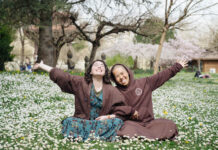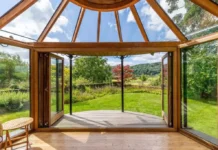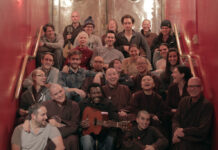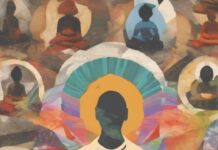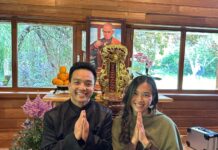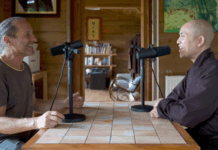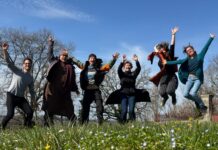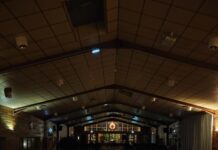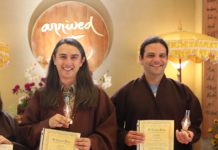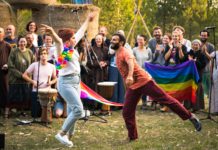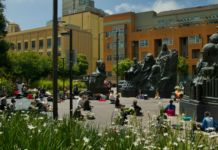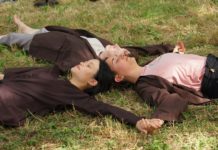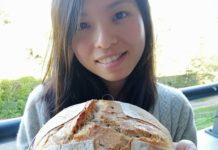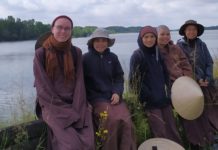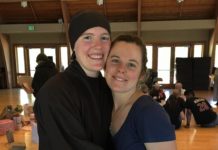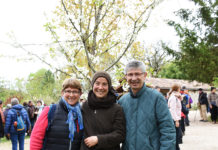Opportunities for Hong Kong and Southeast Asian Young People
—-Chân Pháp Nguyen—
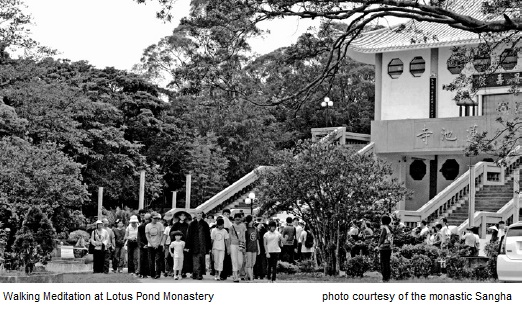 The Cathay Pacific plane from Taipei to Hong Kong was in a gentle descent. From high above, Hong Kong was a city of countless highrises. The clock in the airport read exactly 11:30 AM, April 25, 2011. The thirty monks and nuns were welcomed at the airport by the Hong Kong sangha, and transported to the newest Plum Village monastery. There was one small car for Thay and his attendants, and three buses each seating 20 people: one for the brothers, one for the sisters, and one for luggage. The three buses followed Thay’s car to Lotus Pond Temple in the village of Ngong Ping on Lantau Island, Hong Kong.
The Cathay Pacific plane from Taipei to Hong Kong was in a gentle descent. From high above, Hong Kong was a city of countless highrises. The clock in the airport read exactly 11:30 AM, April 25, 2011. The thirty monks and nuns were welcomed at the airport by the Hong Kong sangha, and transported to the newest Plum Village monastery. There was one small car for Thay and his attendants, and three buses each seating 20 people: one for the brothers, one for the sisters, and one for luggage. The three buses followed Thay’s car to Lotus Pond Temple in the village of Ngong Ping on Lantau Island, Hong Kong.
Halfway up the mountain, we could see a huge bronze Buddha (the largest seated bronze Buddha statue in the world), sitting majestically on the mountaintop. The way up was very beautiful, hugging the mountain on one side and looking steeply down to the South China Sea on the other. Lush vegetation surrounded the roads winding up and down which added to the spectacular landscape. It took a little over half an hour to get to the top of the mountain. There were many tourists and pilgrims visiting and praying in front of the statue of the Awakened One. This mountain, adorned with the giant statue, is one of the famous tourist attractions of Hong Kong.
In front of us was the large and imposing white granite main gate to Polin Temple. The place was bustling with people. Rarely do they notice that just to the left of this busy gate is a small paved road of about 150 meters leading to the hidden Lotus Pond Temple? In there the atmosphere is quiet and full of the flavor of Zen—a world totally different from the one outside. Leaving the bus, we found Thay already sitting in the shade of an ancient banyan tree, enjoying his tea. We bowed to him. He pointed at the tree and says, “”This is an old friend of Thay’s.”
We learned that Thay had left his footprint here over 40 years ago. It was very moving to witness this return. How fortunate that Thay is still here to be the old sturdy banyan tree for his spiritual descendents to take refuge in. “Let’s first go to the Buddha Hall to touch the earth before the Buddha before we eat; we are not allowed to eat without paying respect first to the Buddha!” said Thay in his gentle way, with a smile. We were moved. Truly a reminder in the language of a gentle father.
The first seeds
The seeds of a center had already been sown in Thay’s first teaching visit to Hong Kong, in 2001. In May 2007, during Thay’s third trip here, a practice community called Plum Village Hong Kong was formed. After that trip, Br. Pháp Khâm and other Plum Village brothers and sisters residing in Vietnam and Thailand would come back to Hong Kong every three months to lead retreats and provide guidance to practitioners. In February 2009, a mindfulness practice center was established in the commercial and tourist area Tsim Sha Tsui, Kowloon, with Brothers Pháp Khâm, Pháp Chung and Pháp Dung as permanent residents. Although located right in the crowded downtown, the brothers have been able to maintain diligent practice, keeping the same daily schedule of sitting, walking, and working meditation as at the other Plum Village centers. Some practitioners come to sit with the brothers in the early morning, but the majority come after work for the afternoon walking meditation in the park, and sitting meditation in the evening. These practitioners see the importance of the practice which helps them feel less stressed and brings them peace and happiness in everyday life. On rainy days, the walking would be done in subway halls. Hong Kong, especially the Tsim Sha Tsui area, is extremely crowded. Many people in this small territory live in small highrise condominiums. The light and relaxed steps of walking meditation among such crowded quarters are an unusual occurrence that surprises many onlookers.
Thay’s 2010 teaching tour brought much benefit to many in Hong Kong. Over 1400 people participated in the retreat held at the Hong Kong YMCA. Over 300 people received the Five Mindfulness Trainings at the end of the retreat. Among those was a Venerable monk from another part of China. He had obviously received the Five Precepts elsewhere, but when asked about this the Venerable insisted, “The Five Mindfulness Trainings as enunciated by Plum Village are so wonderful, I would like to receive them so I may transmit them to my disciples.” There was also an ordination ceremony for 25 new Order of Interbeing members from Hong Kong. It was a ceremony of warmth and great joy.
During this same tour, Thay gave a public talk at Hong Kong Convention Center to over 8,000 people. A Venerable from Hong Kong observed, “Only Zen Master Nhat Hanh has the ability to attract such a large audience. Normally, we would be very happy if 80 people came to a Dharma talk.” Thay’s teaching tour made a big impact on intellectuals and business leaders, especially in the Hong Kong press. There were many news articles on Thay and the Plum Village monastic sangha as well as the teachings given during the tour.
One businessman interviewing Thay inquired, “Which realm would you prefer to go to when you die?” Thay looked at the person with his compassionate eyes, then gently answered with a smile, “It does not matter where I go. If we live deeply and solidly in the present moment, and are happy right here and now, then we will be happy no matter where we go.” Thay’s answer surprised the businessman. Normally people think that Thay might want to go either to Nirvana or the Pure Land, or the Tushita Heaven to help Maitreya Buddha prepare his appearance on Earth, or even back to this world to help people achieve liberation. But Thay’s answer was so very practical and totally different from normal expectations.
Sharing about a future for Buddhism in Hong Kong
After the interview, the businessman described the status of Buddhism in Hong Kong and the difficulties practitioners were facing. Young people were no longer interested in coming to the temples. There were fewer and fewer monastics. He spoke of his dream to reintroduce Buddhism in Hong Kong in a way that could bring more peace and happiness to individuals and communities. He acknowledged that wealth, power and fame would not bring true happiness and peace.
Thay said the only way to achieve such a goal was to bring forth a renewed Buddhism, responsive to the needs of today’s individuals and society. There had to be practices to help people relax, have less stress, calm the body and mind, resolve personal difficulties and suffering, bring reconciliation between family members, friends and colleagues, and generate the energy of peace and happiness in the present moment. We should work to establish a healthy environment that appeals to the young people. If not, they would no longer come to the temples and Buddhism would seriously degenerate over time. This phenomenon had happened and was still happening – not only to Buddhism but also to Christianity, and not only in Hong Kong but in other countries as well – and would continue in the same direction if we failed to renew our spiritual tradition.
Thay went on to share about the practice of monastics at mindfulness centers at Plum Village in France, Deer Park Monastery, Blue Cliff Monastery and Magnolia Grove Monastery in the USA, Nhap Luu in Australia, and Tu Hieu in Vietnam. The European Institute of Applied Buddhism (EIAB) in Germany brings the practice of Buddhism to modern society in the most intimate and practical way. In these centers, all practitioners regardless of spiritual background may participate in and benefit from the wisdom of the Buddha.
At EIAB, unlike other Buddhist institutes around the world, the teaching staff includes more than 50 monastics residing together. The monastics live, practice, and teach, on-site, twenty-four hours a day. Classes are taught on subjects such as living in harmony with others, managing anger and other emotions, ministering to the dying, etc. Retreats of various lengths are held (please visit the website www.eiab.eu for more details on classes and retreats). What is taught by the monastic staff can be practiced right after the teaching sessions. Consultations may be quickly set up with the monks and nuns to resolve any question. The energy of the practice is pervasive and palpable. Every Sunday is a public Day of Mindfulness, open to everyone. The monastics in residence are the bedrock of the Institute. Having such a large number of monastics in residence helps create a strong practice energy and brings the quality and effectiveness of instruction to a very high level.
Thay said we could also establish an Asian Institute of Applied Buddhism (AIAB) in Hong Kong, known as one of the four rising tigers of Asia and as a land of respect for human rights and religious freedom. If an AIAB was established in Hong Kong, it would help not only Hong Kong and in particular its youth, but also countless others in East Asia.
The businessman was very interested in Thay’s statement. He said he had a good-sized temple on Lantau Island, about a 90-minute drive from downtown Hong Kong, which could be offered to Plum Village for use as a practice center, if Thay agreed. Ideas were exchanged between Thay’s senior disciples and the businessman, who offered to transport Thay and some monastics to visit the temple the following morning. The offer to make the temple into a Plum Village practice center was happily accepted.
Coming to the new home
Our sisters moved into the new temple, called Lotus Pond (Lien Tri), nearly a month before our arrival in April 2011. The temple is well laid out and spacious, built in the traditional architecture of Chinese temples. The Buddha Hall, which can seat around 150 people, occupies the top of the three-floor building. The middle floor is the residence of the sisters, and the bottom floor is divided into two parts: in front is the ancestors’ hall, and behind it is the dining hall. Outside and to the left of the temple is Thay’s cottage, next to the path leading to our new Bamboo Forest (Truc Lam) Temple where the brothers live. The Bamboo Forest Temple is not as large as Lotus Pond, but it is a comfortable and cosy place for the brothers to live and practice together.
This latest trip to Hong Kong originally was not part of the 2011 Asia tour itinerary, which was scheduled to include only Thailand, Taiwan and Japan. However, due to last-minute contingencies in Japan, that portion of the tour had to be canceled. Thay and the sangha then took the opportunity to travel to Hong Kong to visit our newborn temples. Thay said, “Perhaps, it was the intention of our spiritual ancestors to give us two weeks of rest.”
In the last few days of our stay, Thay took us to visit a number of temples on Lantau Island. Most of these temples are deserted, or occupied only by one, two or three people. We were saddened to see the temples so abandoned. According to local Venerables, the number of monastics in all the temples in Hong Kong totals only about 200. One sister shared that once, on a round to visit nearby temples, she sighted a rather large one on the mountain, with beautiful architecture. Full of anticipation, she went to up for a visit. When she arrived, she found all the gates locked. She rang the bell at the front gate. After a while, a man came out and asked, “What do you want?”, which woke her up to the stark reality that the temple housed no monastics, only a manager and caretaker.
————–
Thay’s Announcement of the Birth of the Asian Institute of Applied Buddhism (AIAB)
On April 28, 2011, in his first Dharma talk at Lotus Pond Monastery, Thay stated that Lotus Pond would be the foundation of the AIAB, whose purpose is to offer retreats to youth, families, social workers, government officials, teachers, businessmen, psychotherapists, etc. from Hong Kong and other Asian countries. AIAB will also train monastic and lay Dharma teachers for Hong Kong and other neighboring countries. Furthermore, AIAB will offer coursework and guidance in the practice towards a Master of Applied Buddhism degree in a cooperative program with Thailand’s Buddhist Universtiy Mahachulalongkornrajavidyalaya. This will be a two-year curriculum which requires residency at the Monastery under the guidance of the monastics.
In addition, AIAB will offer a Day of Mindfulness (DOM) every Sunday to the public. The DOM schedule will typically be:
0930 Walking mediation
1030 Dharma talk
1230 Mindful lunch
1400 Deep relaxation
1500 Dharma sharing
1700 Closing
AIAB will have a minimum of 30 monastics in residence. This minimum is required to provide the appropriate level of support and guidance to the various programs. Thay believes that with the inspiration of AIAB, young people from local areas and neighboring countries will come to apply for the monastic program. The number of monastics in residence will gradually increase to 125, and it is Thay’s wish that a third of these be from Hong Kong. The audience responded with a round of applause, Plum Village style.
The first Sunday Day of Mindfulness at Lotus Pond Monastery was attended by over 200 people, mostly invited from the Hong Kong sangha. The DOM included a ceremony to offer the temple to Plum Village for the establishment of the AIAB. The ceremony was modeled after the simple procedure used by King Bimbisara. According to this ancient Indian tradition, the offering has to be handed personally to the receiver. If the object of offering is too large or something that cannot be touched or seen, water is poured onto the hand of the receiver. When offering the Bamboo Forest Monastery to the Buddha, King Bimbisara knelt in front of the Buddha with a container of water in his hands. After expressing his respect and wish to make the offer to the Buddha, the king poured water into the Buddha’s palms. The businessman who offered the Lotus Pond Monastery likewise asked to make the offer, then poured water onto Thay’s hands. The ceremony signified Thay’s acceptance of Lotus Pond Monastery for the establishment of a Plum Vilalge practice center in Hong Kong, and marked the formation of the AIAB.
After the offering ceremony, the lay practitioners were jubilant. One woman related that because she wanted to be able to come for the weekly practice, she had quit her previous job in order to have a schedule that would allow her to come every Sunday. She has now found a new job, with permission from supervisors for time off during weekends for practice at the monastery.
There were over 350 participants at the second (Sunday) DOM – 150 people more than the previous week. The day began with walking meditation at 9:30 in the morning, led by Thay. In addition to the regular schedule, the monastic sangha also held a Vesak (Buddha’s birthday) celebration ceremony after Thay’s dharma talk. The children who helped set up the statue of the baby Buddha with the monastics in the front garden, were very happy to be given first priority to bathe the baby Buddha. Some young people even got back in line for a second round. The ceremony, simple in form yet very deep in meaning, made people feel light and nourished.
After the ceremony, the sangha was invited to have lunch in mindfulness with Thay. We all sat in a circle in the cool and refreshing atmosphere under the trees of the monastery’s front yard. Among us was Father Thomas Kwong, a Catholic priest from Hong Kong who had received the Five Mindfulness Trainings at Plum Village. The image of teacher and disciples quietly enjoying a meal together in this way reminded one of the Buddha with the original sangha. One practitioner remarked, “To have a quiet meal with Thay and the sangha like this is rather like having the honor of sharing a meal with the Buddha.”
Another practitioner, a Hong Kong woman of Vietnamese origin, said joyfully, “Now that our temple is here, we feel like we have the home of our maternal grandmother to come back to.”

